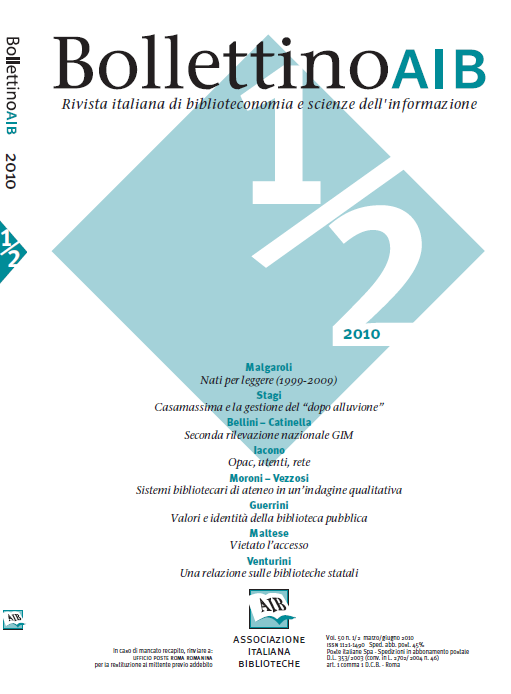Second national survey GIM
Main Article Content
Abstract
At the end of the year 2000 some Italian universities gathered to create the Interuniversity Group for the monitoring of Italian university libraries (GIM). GIM is a formal group whose aims are to define similar methodologies to measure and evaluate academic library services, to foster a permanent measurement of academic library services, to encourage the building and further development of library systems within the universities, to develop national and international projects of measurement and evaluation of academic library services.
Main objective of the group is to define and maintain a set of indicators suitable to be adopted at national level, to allow a benchmarking both between similar libraries within one single university and between different library systems as a whole. The indicators were selected looking at what was already in use in Italian university libraries and at the professional national and international literature. The group made
a special effort to select and developed a set of indicators that were based on data easy to calculate in the real context of Italian libraries, taking into account the fact that not every library was used to collect a wide range of statistical data. As a result, one set composed by 40 indicators was formed.
During 2003 GIM run the first statistical survey. The final report was released and made available online in April 2004.
A second general survey run in 2007 is the object of this article.
The data have been analyzed from different points of view. First of all the group analyzed them in the most simple way: the data were read and on this basis a description was made. The second step was to rank the results for each indicator. This allows a benchmarking through a comparison of the results achieved by the universities. Finally, a multivariate statistical survey was run in order to make it easier a deeper understanding of the results and to identify some trends for different groups of universities. The descriptive analysis and the indicators show some quite clear national trends such as the centralization of the university library systems and their rationalization.
Main objective of the group is to define and maintain a set of indicators suitable to be adopted at national level, to allow a benchmarking both between similar libraries within one single university and between different library systems as a whole. The indicators were selected looking at what was already in use in Italian university libraries and at the professional national and international literature. The group made
a special effort to select and developed a set of indicators that were based on data easy to calculate in the real context of Italian libraries, taking into account the fact that not every library was used to collect a wide range of statistical data. As a result, one set composed by 40 indicators was formed.
During 2003 GIM run the first statistical survey. The final report was released and made available online in April 2004.
A second general survey run in 2007 is the object of this article.
The data have been analyzed from different points of view. First of all the group analyzed them in the most simple way: the data were read and on this basis a description was made. The second step was to rank the results for each indicator. This allows a benchmarking through a comparison of the results achieved by the universities. Finally, a multivariate statistical survey was run in order to make it easier a deeper understanding of the results and to identify some trends for different groups of universities. The descriptive analysis and the indicators show some quite clear national trends such as the centralization of the university library systems and their rationalization.
Article Details
Section
Articles

This work is licensed under a Creative Commons Attribution-ShareAlike 4.0 International License.
